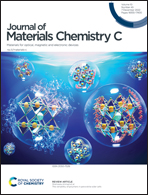Hydroxide-based magneto-ionics: electric-field control of a reversible paramagnetic-to-ferromagnetic switch in α-Co(OH)2 films†
Abstract
Magneto-ionics has emerged as a promising approach to manipulate magnetic properties, not only by drastically reducing power consumption associated with electric current based devices but also by enabling novel functionalities. To date, magneto-ionics have been mostly explored in oxygen-based systems, while there is a surge of interest in alternative ionic systems. Here we demonstrate highly effective hydroxide-based magneto-ionics in electrodeposited α-Co(OH)2 films. The α-Co(OH)2, which is a room temperature paramagnet, is switched to ferromagnetic after electrolyte gating with a negative voltage. The system is fully, magnetically reversible upon positive voltage application. The origin of the reversible paramagnetic-to-ferromagnetic transition is attributed to the ionic diffusion of hydroxyl groups, promoting the formation of metallic cobalt ferromagnetic regions. Our findings demonstrate one of the lowest turn-on voltages reported for propylene carbonate gated experiments. By tuning the voltage magnitude and sample area we demonstrate that the speed of the induced ionic effect can be drastically enhanced.



 Please wait while we load your content...
Please wait while we load your content...